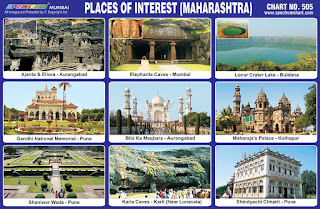 |
| Places of Interest (Maharashtra) Chart |
Spectrum Chart - 505 : Places of Interest (Maharashtra)
1. Ajanta & Ellora (Aurangabad) –
Ajanta Caves in Aurangabad district of Maharashtra are about 30
rock-cut Buddhist cave monuments which date from the 2nd century BCE
to about 480 or 650 CE. The caves include paintings and sculptures
described as "the finest surviving examples of Indian art,
particularly painting", which are masterpieces of Buddhist
religious art, with figures of the Buddha and depictions of the
Jataka tales.
Ellora is an UNESCO World Heritage Site
and forms one of major tourist attraction in Marathwada region of
Maharashtra. Ellora represents the epitome of Indian rock-cut
architecture. The 34 "caves" are actually structures
excavated out of the vertical face of the Charanandri hills. Hindu,
Buddhist and Jain rock-cut temples and viharas and mathas were built
between the 5th century and 10th century. It is a protected monument
under the Archaeological Survey of India.
2. Elephanta Caves (Mumbai) - Elephanta
caves are a network of sculpted caves located on Elephanta Island or
Gharapuri in Mumbai Harbour. The island consists of two groups of
caves the first is a large group of five Hindu caves, the second, a
smaller group of two Buddhist caves. Elephanta caves were designated
a UNESCO World Heritage Site in 1987.
3. Lonar Crater Lake (Buldana) - Lonar
Lake is a saline soda lake located at Lonar in Buldhana district,
Maharashtra, India, which was created by a meteor impact during the
Pleistocene Epoch and it is the only known hyper velocity impact
crater in basaltic rock anywhere on earth. This lake, which lies in a
basalt impact structure, is both saline and alkaline in nature.
Geologists, ecologists, archaeologists, naturalists and astronomers
have published studies of various aspects of this crater lake
ecosystem. Lonar Lake has a mean diameter of 1.2 km and is about 137 m
below the crater rim. The meteor crater rim is about 1.8 km in
diameter.
4. Gandhi National Memorial (Pune) –
Gandhi National Memorial is located in the premises of Aga Khan
Palace. The palace is closely linked to the Indian freedom movement
as it served as a prison for Mahatma Gandhi, his wife Kasturba
Gandhi, his secretary Mahadev Desai and Sarojini Naidu. It is also
the place where Kasturba Gandhi and Mahadev Desai died. In 1969, Aga
Khan Palace was donated to the Indian people by Aga Khan IV as a mark
of respect to Gandhi and his philosophy. Today the palace houses a
memorial on Gandhi where his ashes were kept. The palace archives a
number of photos and portraits depicting glimpses from the life of
Mahatma Gandhi and other personalities of the Indian freedom
struggle.
5. Bibi Ka Maqbara (Aurangabad) - Bibi Ka
Maqbara is a maqbara located in Aurangabad, Maharashtra. It was built
by Azam Shah son of Aurangzeb, in 1678 in memory of his mother,
Dilras Banu Begum. It bears a striking resemblance to the famous Taj
Mahal. Due to the strong resemblance, it is also called the Dakkhani
Taj (Taj of the Deccan). The mausoleum was intended to rival the Taj
Mahal, but the decline in architecture and proportions of the
structure, both due to the severe budgetary constraints imposed by
Aurangzeb had resulted in a poor copy of the latter.
6. Maharaja's Palace (Kolhapur) –
Maharaja's Palace is a historic building in Kolhapur, Maharashtra. It
was constructed during 1877–1884. Being an excellent specimen of
architecture built in black, polished stone, it has been an
attraction for tourists. It has extensive premises with a garden,
fountain and wrestling ground. On every glass are painted the events
in Shivaji's life. There is a zoo and a ground lake. Even today, it
is the residence of Shreemant Chhatrapati Shahu Maharaj, the direct
descendent of Chhatrapati Shivaji Maharaj, the founder of Maratha
Empire.
7. Shaniwar Wada (Pune) – Shaniwar Wada
is an 18th-century fortification in the city of Pune in Maharashtra.
Built in 1732, it was the seat of the Peshwa rulers of the Maratha
Empire until 1818, when the Peshwas lost control to the East India
Company. The fort itself was largely destroyed in 1828 by an
unexplained fire, but the surviving structures are now maintained as
a tourist site. The Shaniwar Wada was originally a seven storied
capital building of the Peshwa empire.
8. Karla Caves (Karli) - Karla Caves are a
complex of ancient Indian Buddhist rock-cut cave shrines located in
Karli near Lonavala, Maharashtra. The shrines were developed over the
period – from the 2nd century BC to the 5th century AD. The oldest
of the cave shrines is believed to date back to 160 BC. The karla
cave complex is built into a rocky hillside with large windows cut
into the rock to light the cave interiors. The caves are believed to
be some of thousands of similar caves excavated in the Sahyadri Hills
in the early 1st millennium AD.
9. Shindyachi Chhatri (Pune) - Shinde
Chhatri, located in Wanawadi, a well known place in Pune, India, is a
memorial dedicated to the 18th century military leader Mahadji Shinde
who served as the commander-in-chief of the Maratha army under the
Peshwas from 1760 to 1780. It is one of the most significant
landmarks in the city and is reminiscent of the Maratha rule. The
major attraction of the Shinde Chhatri of Pune is its exquisite
architecture, reflecting the style used in Rajasthan. The memorial
retains its architectural design and beauty till date.

No comments:
Post a Comment